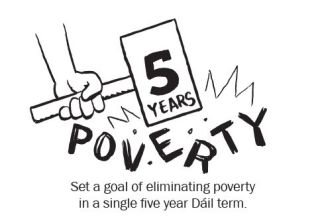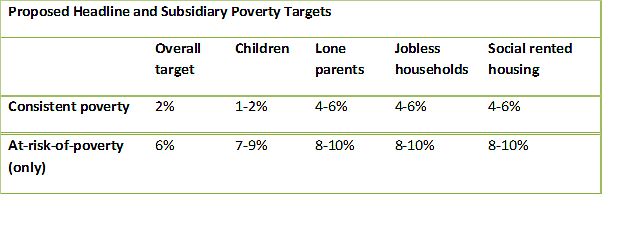Ambition on poverty reduction essential

Government should strive to create a new economic model based on fairness. This would ensure that the benefits accruing from a vibrant economy would be distributed in a more equal manner. Addressing poverty and social exclusion will play a key role in this regard. The new Government should set an ambitious national poverty reduction target and make persistent poverty the primary indicator of poverty measurement.
Poverty Targets – background
The National Action Plan for Social Inclusion 2007-2016 (NAPinclusion) published in early 2007 set its overall poverty goal using this earlier consistent poverty measure. One of its aims was to reduce the number of people experiencing consistent poverty to between 2 per cent and 4 per cent of the total population by 2012, with a further aim of eliminating consistent poverty by 2016. A revision to this target was published as part of the Government’s National Reform Programme 2012 Update for Ireland (2012). The revised poverty target was to reduce the numbers experiencing consistent poverty to 4 per cent by 2016 and to 2 per cent or less by 2020. This target has been retained, and the time period extended to 2025, as part of Government’s Roadmap for Social Inclusion 2020-25 (Government of Ireland, 2020). Social Justice Ireland participated in the consultation process on the revision of this and other poverty targets. While we agree with the revised 2 per cent consistent poverty target (it is not possible to measure below this 2 per cent level using survey data) we proposed that this target should be accompanied by other targets focused on the overall population and vulnerable groups.
It should also be noted that, despite various Governments establishing and revising poverty targets on a number of occasions over the past decade, none of these have been achieved
Set an ambitious national poverty reduction target
Social Justice Ireland suggests that Government must set a 5-year plan for dramatically reducing poverty in Ireland as part of any Programme for Government. With the uncertainty being created by Brexit, including the potential impact on our economy, this kind of clear policy commitment is all the more important to protect the most vulnerable in Irish society. Ireland needs this kind of centralised policy commitment to mobilise a multi-departmental approach to the crisis of poverty.
Social Justice Ireland proposes that the Roadmap for Social Inclusion should be updated and that the following should be adopted as Ireland’s target for poverty reduction:
To reduce by 2023 the consistent poverty rate to 2%; the at-risk-of-poverty rate anchored in time[1] to 7%; and the at-risk-of-poverty (only) rate to 6%.
These headline targets should be accompanied by subsidiary poverty targets for vulnerable groups as follows:

Ambitious targets are the only way that Ireland will address its on-going poverty problem. The targets outlined above are, we believe, appropriate targets for the Programme for Government. These targets are stepping stones to move Ireland’s income support system closer to the Minimum Essential Standard of Living[2].
Make persistent poverty the primary indicator of poverty measurement
Social Justice Ireland is committed to using the best and most up-to-date data in its ongoing socio-economic analysis of Ireland. We believe that to do so is crucial to the emergence of accurate evidence-based policy formation. It also assists in establishing appropriate and justifiable targeting of state resources.
As part of the EU structure of social indicators, Ireland has agreed to produce an indicator of persistent poverty. This indicator measures the proportion of those living below the poverty line in the current year and for two of the three preceding years. It therefore identifies those who have experienced sustained exposure to poverty which is seen to harm their quality of life seriously and to increase levels of deprivation.
To date the Irish SILC survey has not produced any detailed results and breakdowns for this measure. We regret the unavailability of this data and note that there remain some sampling and technical issues impeding its annual publication. However, we note ongoing moves by the CSO to address this issue.
Social Justice Ireland believes that this data should be used as the primary basis for setting poverty targets and monitoring changes in poverty status. Existing measures of relative and consistent poverty should be maintained as secondary indicators. If there are impediments to the annual production of this indicator, they should be addressed and the SILC sample augmented if required. A measure of persistent poverty is long overdue and a crucial missing piece in society’s knowledge of households and individuals on low income.
[1] For a given year, the “at risk of poverty rate anchored at a moment in time” is the share of the population whose income in a given year is below the at risk of poverty threshold calculated in the standard way for a previous base year and then adjusted for inflation. The purpose of this indicator is to get some indication of the changes in ‘absolute poverty’ over time. For more details see https://www.cso.ie/en/releasesandpublications/ep/p-silc/surveyonincomeandlivingconditionssilc2017/backgroundnotes/